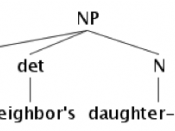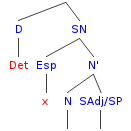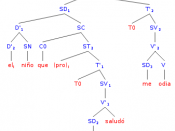I. IntroductionThis paper is an attempt to describe the structure of Ilokano sentences, concurring with the Minimalist program proposed by Noam Chomsky. The Philippine language being considered is under the Northern Philippine subgroup with an estimated 8,000,000 speakers (NSO, 2002-2004). This study is patterned mainly after the Tagalog Sentence Structures: Minimalist Approach of Resty Cena. In this syntactic description, an overview of the language's lexical phrases will be given for starters. It will move on to defining, classifying and describing the basic sentences of the languages. Errors on this study are solely the author's.
II. Lexical PhrasesLexical phrases are headed by a lexical item (as opposed to functional item). Some common lexical phrases in Ilokano are:HeadDPdeterminer phrasedetermineramin dagiti mannalon(lahat ng mga magsasaka)PPpreposition phraseprepositiontalaga nga para iti ubinga(talagang para sa bata)APadjective phraseadjective rootadayu a nalalaing nga estudyante(higit na mas magaling na estudyante)VPverb phraseverb rootkanayun a gumatang ti arak(bumili ng alak)NPnoun phrasenounnapintas a balasang idiay simbaan(magandang dilag sa simbahan)Determiner Phrase (DP)The determiner phrase is headed by a determiner.
Noun phrases serve as complement, and quantifier phrases and adjectival phrases typically serve as specifier.
amin dagiti mannalon (lahat ng mga magsasaka)DP/ \D' QPQuantifier phrase serves as specifier/ \ aminD NP Determiner dagiti is head of the phrasedagiti mannalonThe set of determiner consists of the particles enumerated in the following table.
Ilokano MarkersSingularPluralSingularPluralNon-personaltidagitiiti / idiaykadagiti / kadagidiayPersonalnidaken nikadaLater, we will look more closely at the range of structures that come under DP , like the following:dagiti panday (ang mga panday)idiay dakkel a balay na (sa malaking bahay niya)idiay balay ni Ben (sa kay Ben na bahay)dagiti panday nga agar-aramid ti kanyon (ang mga panday na gumagawa ng kanyon)kadagiti agar-aramid ti kanyo nga panpanday (sa gumagawa ng kanyon na mga panday)Preposition Phrase (PP)A preposition heads the prepositional phrase. Transitive prepositions show complements. Adverbial elements (ADV) serve as specifier.
talaga nga para iti ubing (talagang para sa bata)PP/ \P' ADV/ \ talaga + ngaP DPpara iti ubingAdjective Phrase (AP)The adjective phrase is headed by the adjective root.
adayu a nalalaing ngem ti estudyante (higit na mas magaling na estudyante)AP/ \A' ADV/ \ adayu + aA DP A fully extended x-bar structure inside an x-barnalalaing / \ structureD' Comparative/ \ ngemD Nti estudyanteThe diagram may appear complex, but it is simply our basic x-bar structure (AP), whose head takes a complement that is a fully specified x-bar structure (DP). Complex structures are hierarchies of x-bar structures.
Verb Phrase (VP)The verb phrase is headed by the root of the verb.
kanayun a gumatang ti arak (madalas bumili ng basi)VP/ \V' ADV/ \ kanayunV DPgatang ti arakThe affix -um- is not part of VP. It is head of another projection that we will discuss later.
Noun Phrase (NP)The noun head of a noun phrase may have an attributive phrase as specifier and a PP as complement.
napintas a balasang idiay simbaan (magandang dilag sa simbahan)NP/ \N' AP/ \ napintas + aN PPbalasang idiay simbaanIII. SentencesThis chapter will discuss the types of sentences in Ilokano and how they are formed.
Sentence Types in IlokanoIlokano sentences may be classified according to the type of their predicates.
VerbalGimmatang ti arak ni Juan. (Bumili si Juan ng basi.)AdjectivalTalaga a nasingpet ni Maria. (Talagang mabait si Maria.)NominalAbugado ni Pedro. (Abugado si Pedro.)PrepositionalPara ken ni Ding ti arak. (Para kay Ding ti arak.)ExistentialAdda kuarta na ni Juan. (May pera si Juan.)Occasionally Time and Measurement predicates are sometimes considered to be separate sentence types. More commonly, the time phrase is analyzed as a prepositional phrase, and the measurement phrase an adjective phrase.
TimeIntono Dominggo ti Paskua. (Sa Linggo ang pasko.)MeasurementTallo ti simmangpet. (Tatlo ang dumating.)Sentences with a Verbal Predicate: Voice Affix as HeadThe head of a verbal sentence is the voice affix. To indicate the head of the verbal sentence, we use the same symbol T as used in English, and we call it Tinig "voice".
Gimmatang ti arak ni Juan. (Bumili si Juan ng basi.)Ginatang ni Juan ti arak. (B*inili ni Juan ang basi.) *The voice suffix -in is unrealized.
Gimmatang ti arak ni Juan.
T' T is voice "tinig".
/ \T VP T -um- , not the root bili, specifies the Voice of the verb.
im(m) / \V' DP/ \ ni JuanV DPgatang ti arakWith only an aspect affix, the verb has no subject, thus, Kagatgatang ni Juan ti arak. (Kabibili ni Juan ng basi.) is unacceptable.
Furthermore, panag-nominalizations may show aspect and mode, but it is the lack of voice that conditions an unselected subject.
ti panag-ininum ni Juan ti basiCVr - is aspect; no voice, no subject(ang pag-iinom ni Juan ng basi)ti panagpaala ni Juan ti pulutanaffix pa- is mode; no voice no subject(ang pagpakuha ni Juan ng pulutan)Later on we will show that T carries a feature that, when satisfied, displaces the agent si Ben to subject position.
Sentences with an Adjective Predicate: Adjectivalizer Affix as HeadThe essence of adjectival sentences is the conferment of an attribute, expressed mainly by the adjective head of the predicate, to the subject. The adjective is an attribute term through na- affixation on a base. The head T of the adjectival sentence is Tangi (from katangian) "attribute", realized in many adjectives as na-.
Talaga a nasingpet ni Maria. (Talagang mabait si Maria.)TP Tangi (from katangian) Phrase/ \T' DP/ \ ni MariaT AP The adjectivalizer na- serves as T "tangi"na / \A ADVsingpet talaga + aA few bare adjectives, for example, pandek, dakkel etc., don't accept the na- affix, thus, *napandek, *nadakkel, but show a subject.
Pandak ni Ben.*Napandak ni Ben.
Dakkel ti balay na.*Nadakkel ti balay na.
Intensive SentencesThe intensive predicate head has the form: nag + adjective stem.
Nagswerte ni Ben. (Napakasuwerte ni Ben.)Nagswerte ni Ben. (Napakasuwerte *si Ben.)Nagswerte ni Ben. (Napakasuwerte ni Ben.)TP Intensifier (small) phrase/ \T' DP/ \ ni Bennag AP/ \A' DP/ ni BenAswerteLike na-, the intensifier can copy ni Ben to the specifier position.
Superlative SentencesSuperlative adjective predicates also have subjects.
Kaswertian ni Ben. (Pinakamasuwerte si Ben.)TP/ \T' DP/ \ ni BenT AP Superlative (small) phraseka + suwerte + an / \A DPswerte ni BenDuring the merging of the head T ka-â¦-an and AP, the head ka-â¦-an, possessing a strong feature, is able to copy-raise si Ben to specifier.
ExclamativesExclamatives are treated like intensive sentences.
Nakasulsulpeng ni Ben. (Ang pasaway ni Ben.)cf. Ang pasaway *si Ben.
DP/ \T' DP/ \ ni BenT APnaka + CV(C)r sulpengSentences with a Locative Predicate: Locative Affix is HeadThe locative marker 'affix' na- may also serve as head of the predicate phrase.
Talaga nga adda idiay taltalon ti trabaho. (Talagang naroon sa bukid ang trabaho.)TP Tukoy (from pantukoy) Phrase/ \T' QP/ \ ti trabahoT DPThe 'affix' na- serves as Tadda / \D' ADV/ \ talaga + ngaD Nidiay taltalonOther examples:Adda idiay taltalon ni Juan. (Nasa bukid si Juan.)Adda ken ni Ben ti kuarta. (Nasa kay Ben ang pera / Nakay Ben ang pera.)Sentences with an Existential Predicate: Head is Existential ParticleThe head of an existential sentence is the existential particle may.
Adda kuarta na ni Juan. (May pera si Juan.)T'/ \T VPadda / \V' DP/ \ ni JuanV DPÃÂ kuartaThe placement of the third person genitive pronoun na in the structure is unknown to the author up to this point.
Other examples of this kind of sentence:Adda kuarta. (May pera.)Adda kuarta ken ni Ben. (May pera kay Ben.)Adda kuarta ni Ben ken ni Obet. (May pera kay Obet si Ben.)Adda kuarta ken ni Ben. (Mayroong pera kay Ben.)Sentences with a Nominal Predicate: Head is the Nominalizer AffixMany Ilokano nominals are non-derived, for example, abugado, panday, suldado, etc. But many are derived, for example, mangngalap, mannalon, tagaluto, tagabantay, etc.
Bare nominals as predicateAbugado ni Ben. (Abugado si Ben.)Suldado ni Erwin. (Sundalo si Erwin.)Derived nominals as predicateTagaluto ni Paeng. (Tagaluto si Paeng.)Mangngalap ni Ador. (Manggalap ni Ador.)The following diagram shows the nominalizing affix taga- as head. .
Tagaluto ni Paeng. (Tagaluto si Paeng.)T'/ \T VPtaga / \ The noun-forming affix taga serves as TV DPluto ni PaengAs for sentences with bare nouns as predicate, a null T variant of the nominalizer taga is proposed. The absence of an affix is what distinguishes pure nouns from adjectives and verbs.
Suldado ni Erwin. (Sundalo si Erwin.)T'/ \T VPÃÂ / \V DPsuldado ni ErwinOther Non-Derived Predicate HeadsIn addition to bare adjectives and bare nouns, other word classes may serve as head of the predicate phrase.
Intono bigat ti Paskuaintono bigat is a time word(Bukas ang Pasko.)Tallo ti simmangpet.tallo is a cardinal number(Tatlo ang dumating.)Time phrases are considered prepositional phrases in Ilokano.
Intono Dominggo ti Paskua (Sa Linggo ang Pasko.)Idi Dominggo ti Paskua (Noong Linggo ang Pasko.)Measurement phrases are likely to be truncated noun phrases:Tallo ti simmangpet.cf. Tatlong tao ang dumating.
(Tatlo ang dumating.)IV. The Subject of the SentenceSubject as SpecifierWhere do subjects come from?Subject as Specifier of VPIt is standard practice in minimalist analysis to locate the agent phrase (which is the default subject phrase in English and other languages) initially in the specifier position of VP (spec-VP), as shown in the diagram below.
Predicate-Internal Argument HypothesisAll the arguments of a predicate originate within a projection of the predicate.
As shown below, ni Ben is under VP and within the projection of the verb gatang 'buy'.
Gimmatang ni Ben ti basi. (Bumili si Ben ng basi.)T'/ \T VPum / \V' DP ni Ben originates as projection of V into spec-VP/ \ ni BenV DPgatang ti arakSubject as Specifier of TPOn the above structure, EPP applies and copies ni Ben into spec-TP, as shown in the diagram below. The strikethrough on the original ni Ben indicates that the phrase has been copied.
TP/ \T' DP/ \ ni BenT VP[EPP] / \um V' DP/ \ ni BenV DPgatang ti basi"Copy / Move" creates structures, in this case, TP. It is a form of merge, since it creates a structure by merging two structures, in this case the constituent structures T' and DP. The constituent structures originate inside the tree, hence it is called internal merge. In contrast, regular merge joins structures coming from the lexicon, hence, it is called external merge.
This process is called spec-VP-to-Spec-TP movement. It is an example of A-movement, so called because movement is to an argument position.
The Predicate-Internal Argument Hypothesis makes it easy to map structural and thematic arguments. For example, the DP specifier maps to the agent role, and the DP complement to the patient role.
The feature [EPP] triggers the extension of the head um to a TP projection, and spec-VP raises to spec-TP. The Attract Closest Principle insures that EPP moves the right constituent.
Attract Closest Principle (ACP)A head which attracts a given kind of constituent attracts the closest constituent of the relevant type which it c-commands.
In our example, T matches the DP ni Ben. (Matching is explained under the section on Agreement).
When the verb carries the patient voice affix, it is the complement basi and not the agent Ben that raises (note that the determiners ni and ti are only convenient labels used in place of the set of grammatical features representing those determiner positions). How does Attract Closest know which is the relevant nominal to operate on? Case marking, which we discuss under Agreement, could help.
Ginatang ni Ben ti arak. (Verb carries the unrealized -in voice affix)(Binili ni Ben ang basi.)TP/ \T' DP/ \ ti basiT VP[EPP] / \in V' DP/ \ ni BenV DPgatang ti basiRaisingAnother example of A-movement is subject raising. In the examples below, the italicized subject siya is raised outside of the embedded clause and into the main sentence.
Pinilit ko nga mangan. (Pinilit ko [na kumain])Pinilit ko nga mangan isuna. (Pinilit ko [na kumain siya])Below is the derivation of the second sentence.
TP/ \T' PRN/ \ isunaT VPin / \V' PRN/ \ koV CPpilit / \C TPnga / \T' PRNmangan isunaV. Subjectless SentencesIlokano has many sentences with no ti/ni- phrase (ang-phrase). Since we consider here the ang-phrase as the subject phrase, these sentences would appear to be subjectless.
Recent Perfective SentencesIn recent perfective sentences, the predicate head has the form: ka + CV + stem, where CV is the reduplication of the first CV of the stem.
Kagatgatang ni Ben ti basi. (Kabibili ni Ben ng basi.)Kagatgatang ni Ben ti basi. (Kabibili *si Ben ng basi.)Kagatgatang ni Ben ti basi. (Kabibili ni Ben ?ang basi.)Kagatgatang ni Ben idiay basi. (Kabibili ni Ben sa basi.)A problem appears in the above sentences since Ilokano employs almost the same marker for all arguments. The author is doubtful whether there exists a means of knowing what these determiners are marking.
Kagatgatang ni Ben ti basi. (Kabibili ni Ben ng basi.)Asp' Aspect (small) phrase/ \Asp VPka + gat + gatang / \V' DP/ \ ni BenV DPgatang ti basiNow, ka- is not a voice affix, it is the head of an aspect phrase. The Asp head is weak and cannot copy Ben to serve as its specifier.
Sentences with Affixless VerbsSentences with the affixless predicates such as kayat (gusto/ibig) do not show a subject when the patient is indefinite.
Kayat ni Ben ti basi. (Gusto ni Ben ng basi.)These sentences do not have a head item that can trigger the creation of a new structure above VP that can host a subject.
VP/ \V' DP/ \ ni BenV DPkayat ti basiIn Tagalog, when the patient noun is definite, these affixless verbs require a subject. This can be portrayed in Ilokano through the use of demonstratives.
Kayat ni Ben dayta basi. (Gusto ni Ben iyang basi.)The verb kayat 'gusto' and its synonyms and antonym may, of course, be used like any regular verb, that is, with verbal affixes. These sentences derive normally, with the voice affixes serving as T.
Kinayat ni Ben ni Gina. (Ginusto ni Ben si Gina.)Subjectless Weather VerbsWeather verbs inflect for voice, but, nonetheless don't show a subject, apparently in contradiction of EPP which guarantees that an Ilokano voiced verb will have a subject..
Nagtudo. (Umulan.)Nagtudo idiay Manila. (Umulan sa Maynila.)The structure of the second example is as follows:Nagtudo idiay Manila. (Umulan sa Maynila.)T'/ \T VPnag /[EPP] V'/ \V DPtudo idiay ManilaEPP applies and attempts to extend T to a projection with a subject. However, there is no appropriate constituent that can serve as subject.
So the absence of subject in Nagtudo 'Umulan' and Nagtudo idiay Manila 'Umulan sa Maynila' may simply be because there just isn't any nominal available to serve as specifier of -um-.
Subjectless Existential SentencesSome forms of the existential sentences do not show a subject.
Adda kuarta. (May pera.)*No other argument except the existent.
Adda kuarta ken ni Ben. (May pera kay Ben.)*Second argument is locative-marked.
Adda nakadulin a kuarta ken ni Ben. (May nakatagong pera kay Ben.)cf. May nakatagong pera si Obet kay Ben.
One could say that these sentences do not show a verb, thus:Adda kuarta ken ni Ben. (May pera kay Ben.)TP/T'/ \T VP[EPP] / \adda V' DP/ \ ken ni BenV DPÃÂ kuartaEPP applies but is unable to find the right expression, hence, nothing moves to spec-TP.
One apparent anomaly with existential sentences is that when the existent is a verb form, it must carry a non-agent affix, this despite the fact that the argument is interpreted as agent.
Adda ginatang ni Ben a basi. (May biniling basi si Ben.)*Ben is agent, but ginatang 'binili' has a non-agent voice affix.
Adda gumatang ni Ben a basi. (May *bumiling basi si Ben.)*An agent voice affix renders the sentence unacceptable.
Adda ginatang ni Ben a basi. (May biniling basi si Ben.)CP/ \C' DP/ \ ni BenC TP[EPP, EXIST] / \adda T' DP/ \ ni BenT VP[EPP] / \-in + gatang V' DP/ \ ni BenV DPgatang + a basiOne possible explanation is that ginatang 'binili' is not a verb but a noun, hence, adda ginatang 'may binili' is a nominal expression, in the same sense that ti ginatang 'ang binili' is a nominal.
Adda ginatang na ni Ben. (May binili si Ben.)CP/ \C' DP/ \ ni BenC TP[EPP, EXIST] / \ÃÂ T' DP/ \ ni BenT D'ÃÂ / \D Nadda ginatangThis is questionable since this is the only instance of a possessor nominal (ni Ben) in the nominative rather than in the usual genitive form.
VI. Sentences with 'Double Subjects'Complementiser PhraseComplementiser phrases are headed by the complementiser nga 'na', no 'kung', isu nga 'kaya', etc.
Dependent Clause as CPConsider this: Imbaga ni Ben [nga agawid ka.] (Sinabi ni Ben [na umuwi ka].)The dependent clause nga agawid ka 'na umuwi ka' consists of the complementiser nga and its complement, the TP agawid ka 'umuwi ka'. The whole CP serves as complement of the verb baga 'sabi'.
Imbaga ni Ben nga agawid ka. (Sinabi ni Ben na umuwi ka.)T'/ \T VPin / \V' DP/ \ ni BenV CPbaga /C'/ \C TPnga agawid kaIndependent Clause as CPIt is convenient to regard independent clauses to be CPs as well. Independent clauses typically do not show an overt complementiser phrase.
Naatalan ti pusa. (Hinagip ang pusa.)CP/C'/ \C T' Complementiser head is null.
à/ \T VPna-â¦-an /V'/ \V DPatal ti pusaA bit of support is provided by sentences introduced by exclamatives, where the exclamatives may be considered to serve as C.
Ay, naatalan ti pusa! (Ay, hinagip ang pusa!)C'/ \C TPay / \T' DP/ \ ti pusaT V'na-â¦-an / \V DPatal ti pusaVII. MovementEarlier we have seen the raising of a nominal to the subject position, an example of A-movement, which moves a constituent to an argument position. We discuss here other types of movement processes.
V-to-C MovementAffixes occupy a strong position, and can attract a host to attach to. In the sentence below the affix um attracts the verb gatang 'bili'. Phonetic rules will give the spell-out gumatang 'bumili'. This process is called V-to-T movement and is an example of head-to-head movement, so called because the constituent that moves is a head and its destination is a head position.
Gimmatang ti basi ni Ben. (Bumili ng basi si Ben.)T'/ \T VPum + gatang / \V' DP/ \ ni BenV VPgatang ti basiDefinition of AttractTo say that a head H attracts a constituent C is to say that H triggers movement of C to some position on the edge of HP (so that C may move to adjoin to H, or to become the specifier of H).
The constituent C must be the closest head that H c-commands.
Move is a two-step process: copy then delete. In the diagram above the strikethrough on the original bili shows that it has been copied.
FocalisationFocalisation moves an item outside of TP. Semantically the preposed constituent receives extra emphasis.
Idiay taltalon nga imminum ni Ben idiay taltalon. (Sa bukid uminom si Ben sa bukid.)Idiay taltalon ket imminum ni Ben idiay taltalon. (Sa bukid ay uminom si Ben sa bukid.)We analyze the second example as follows:Ni Ben ket imminum. (Si Ben ay uminom.)CP/ \C' DP/ \ ni Ben [EPP] in C moves spec-TP ni Ben to Spec-CP.
C TP[EPP] / \ket T' DP [EPP] in T moves spec-VP ni Ben to spec-TP.
/ \ ni BenT VP[EPP] / \um + inom V' DP/ \ ni BenV DPinom idiay taltalonFor now, ket is analyzed as a complementiser.
TopicalizationIn topicalization, the preposed constituent represents old information, or an expression that has been established earlier in the discourseTanong: Pumanaw da Obeten. Da Ben ngay? (Aalis na sina Obet. E, Sina Ben?)Sagot: Da Ben, immuna dan. (Sina Ben, nauna na.)Unfortunately, this sentence type is not analyzed in this study.
CleftingIn a cleft sentence, the nominative expression is preposed and separated from the rest of the sentence with the ang particle.
Speaker A: Pulis idiay baryo ni Ben. (Pulis sa baryo si Ben.)Speaker B: (Wen), ni Ben ti pulis idiay baryo. ([Oo], si Ben ang pulis sa baryo.) (cleft sentence)We treat clefting as focalisation, where ti 'ang' is the head of the projection, and where ni Ben 'si Ben' in the above sentence is the focus phrase.
Ni Ben ti pulis idiay baryo. (Si Ben ang pulis sa baryo.)FocP/ \Foc' DP/ \ ni BenFoc DPÃÂ / \D NPti / \N' DP/ \ ni BenN DPpulis idiay baryoWh-MovementWh refers to question words: sino 'sino', ania 'ano', katno 'kailan', sadino 'saan', apay 'bakit' etc. Sino 'sino' and ania 'ano' questions the nominative expression.
Ania ti ginatang ni Ben? cf. Ginatang ni Ben ti basi.
(Ano ang binili ni Ben?)(cf. Binili ni Ben ang basi.)Sino ti gimmatang ti basi?cf. Gimmatang ni Ben ti basi.
(Sino ang bumili ng basi?)(cf. Bumili si Ben ng basi.)The rest are used to question non-nominative expressions.
Sadino a naglangoy ni Ben?Naglangoy ni Ben idiay karayan.
(Saan lumangoy si Ben?)(cf. Lumangoy si Ben si ilog.)Katno a nagawid ni Ben?Nagawid ni Ben idi kalman.
(Kailan umuwi si Ben?)(cf. Umuwi si Ben kahapon.)Apay nga kinanayun ti tudo?Kanayun nga agtudo ta panagtutudo.
(Bakit madalas ang ulan?)(cf. Madalas umulan dahil tag-ulan.)Wh-question is represented as the feature [WH] on question words and the C head of an interrogative sentence. This feature attracts the closest item that C c-commands that also has the [WH] feature, in the example below, the PP saan, and raises it to the C position.
Sadino a naglangoy ni Ben? (Saan lumangoy si Ben.)C'/ \C TP[WH] / \sadino T' DP/ \ ni BenT V'ang + langoy / \V PP/ [WH]langoy sadinoIn the next example, the question word ania 'ano' ends up in the specifier position of CP.
Ania ti ginatang ni Ben? (Ano ang binili ni Ben?)CP/ \C' DP/ \ aniaC DP[EPP, WH] / \ C as probe finds the spec-TP ano as goal and raises itÃÂ D TP to become spec-CPti / \T' DP/ \ aniaT VP[EPP, WH] / \in V' DP/ \ ni BenV DPgatang [WH]aniaAt the highest C level of derivation, [EPP] needs to be satisfied, hence, ACP looks for the closest c-commanded nominal that has a [WH] feature, and that is the DP that is specifier of TP.
Wh-movement is an example of A-bar movement, which moves an argument or an adjunct expression to an argument position.
Successive MoveWhat appears to be 'long-distance' movement is actually an instance of successive local movements. In the examples below, the subject si Pat of the lowest sentence moves successively to the next higher sentence until it reaches the matrix sentence.
Imbaga ni Ben nga impadamag ni Obet nga inlibak ni Ming nga nagawid ni Pat.
(Sinabi ni Ben na ibinalita ni Obet na itinatuwa ni Ming na umuwi si Pat.)Imbaga ni Ben nga impadamag ni Obet nga inlibak ni Ming ni Pat nga nagawid.
(Sinabi ni Ben na ibinalita ni Obet na itinatuwa ni Ming si Pat na umuwi.)Imbaga ni Ben nga impadamag ni Obet ni Pat nga inlibak ni Ming nga nagawid.
(Sinabi ni Ben na ibinalita ni Obet si Pat na itinatuwa ni Ming na umuwi.)Imbaga ni Ben ni Pat nga impadamag ni Obet nga inlibak ni Ming nga nagawid.
(Sinabi ni Ben si Pat na ibinalita ni Obet na itinatuwa ni Ming na umuwi.)VIII. BibliographyCena, R.M. (2006). Overview of Tagalog Sentence Structures: Minimalist Approach. Lecture Notes inLinguistics 140, 2nd semester, 2006-2007. University of the Philippines, DilimanIlocos Sur's Population Growth Rate Doubled After 5 Years. (2002). Retrieved fromhttp://www.census.gov.ph/data/pressrelease/2002/pr0244tx.html on March 29, 2007.





